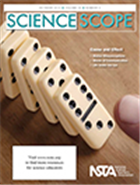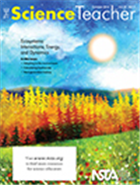Crosscutting Concepts in NSTA Journals
By Mary Bigelow
Posted on 2014-10-12
The more I learn about NGSS, the more I’m intrigued by the crosscutting concepts. These concepts are the big ideas that transcend and connect the core ideas and processes within and in between traditional subject areas. This month’s Science & Children has a guest editorial on the topic that is a must-read for teachers of all levels: Implementing NGSS Crosscutting Concepts
One of the perks of being an NSTA member is having access to all of the journals online. Regardless of the grade level you teach, the journals have ideas for authentic activities and investigations that can be used, adapted, or extended for different levels of student interest and experience. Many are written using the 5E model and most describe their connections to the NGSS. The articles in NSTA’s October K-12 journals focus on three of the NGSS crosscutting concepts: Patterns, Cause and Effect, and Systems and System Models.
 Science & Children: Patterns
Science & Children: Patterns
This issue is the beginning of a series that will address each of the crosscutting concepts with “snapshots” of activities that include the concepts, starting with patterns. Here are some SciLinks that provide additional content information and suggestions for additional activities and investigations:
- Patterns Are Observable, Predictable, and Explainable [Forecasting the Weather, What Is Weather?, Phases of the Moon]
- Leaf It to Nature [Parts of a Plant, Identifying Trees]
- Art and the Cosmic Connection [Solar System, Planets]
- A SeQRet Treasure Hunt [Habitats, What Is a Habitat?]
- Modeling Water Filtration [Water Quality, Water Pollution and Conservation]
- A Pattern in the Sky [Phases of the Moon]
- Find Your School Analemma [Analemma, Sun]
- Biography as Mentor [Biographies of Scientists]

Science Scope: Cause and Effect
Here are some SciLinks that provide additional content information and suggestions for additional activities and investigations:
- Lakes Alive! [Lakes and Ponds, Plankton]
- Model Synergy [Solubility]
- Generating, Evaluating, and Modifying Scientific Models Using Projected Computer Simulations [Molecules and Atoms, Gases]
- Eureka! Causal Thinking about Molecules and Matter [Mass and Volume, Changes of State]
- Conservation of Matter in the Life Sciences [Conservation of Matter, Cellular Respiration, Photosynthesis]
- Students Modeling Molecule Movement Through Science Theater [Molecules and Atoms]
- Teaching Electromagnetic Waves Used in Communication Technologies [Electromagnetic Waves]
- Eclipse—Scope on the Skies [Eclipses]
 The Science Teacher: Ecosystems: Interactions, Energy, and Dynamics
The Science Teacher: Ecosystems: Interactions, Energy, and Dynamics
“Ecosystems” is one of the four core ideas in high school life science. The articles in this issue address the complex interactions in the environment from a systems approach. Here are some SciLinks that provide additional content information and suggestions for additional activities and investigations:
- Calculating Biodiversity in the Real World [Biodiversity]
- Adapting to the Environment [Autumn Leaves, Leaf Structure and Functions, Plant Adaptations]
- Next Generation Botany [Carbon Cycle, Parasites]
- Measure Your Community’s Smog Levels [Smog]
- Busting 10 Myths About Diabetes [Diabetes]
- Putting New Life in an Old Lesson [Thermodynamics]
Disclaimer: The views expressed in this blog post are those of the author(s) and do not necessarily reflect the official position of the National Science Teaching Association (NSTA).


